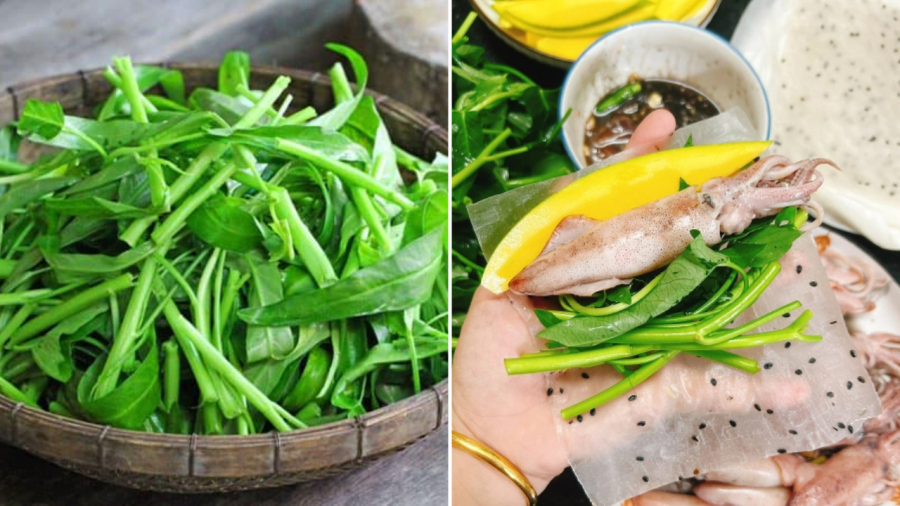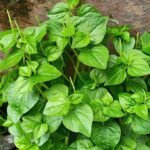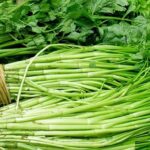Water spinach, or morning glory, is a popular vegetable in Vietnamese cuisine, with its versatility allowing for various cooking methods such as boiling, stir-frying, or even pickling. Some people even enjoy eating it raw, often paired with salads or herb-based dishes. However, nutritionists and doctors advise against consuming raw water spinach due to potential health risks.
The Dangers of Eating Raw Water Spinach
Water spinach is a nutrient-rich vegetable, containing ample fiber, protein, vitamins (A and C), and minerals such as calcium and iron. It also provides essential amino acids such as threonine, valine, and leucine. This vegetable is particularly known for its high iron content, which helps prevent iron deficiency anemia. The abundant fiber in water spinach also aids digestion and prevents constipation.
In traditional Eastern medicine, water spinach is believed to possess cooling properties and a sweet, mild flavor. It is used to cleanse the heat from the body, promote bowel movement, act as a diuretic, and detoxify, helping to treat issues like heat rashes and boils.
However, consuming raw or undercooked water spinach can pose several health risks. It may cause stomach discomfort and pain. More importantly, water spinach can harbor large intestinal flukes, or parasites, with the scientific name Fasciolopsis buski. These parasites are commonly found in aquatic-grown vegetables, including water spinach.

When ingested, the fluke eggs develop into adult flukes, causing minor abdominal pain, diarrhea, and allergies. In severe cases, they can attack the gallbladder, leading to liver damage, cirrhosis, and even liver failure. This is a significant reason why experts strongly advise against eating raw water spinach.
Additionally, water spinach grown in polluted environments can introduce harmful substances into the body when consumed raw. Due to the high demand for this vegetable, some farmers use growth stimulants and pesticides, and they may harvest the crop prematurely to increase profits. Water spinach grown in contaminated ponds, lakes, or rivers is also more likely to contain harmful substances, such as heavy metals, and carry a higher risk of parasitic infections.
Water spinach falls into the category of vegetables with a high risk of containing stimulant and pesticide residues above the safe threshold. Prolonged consumption of such contaminated vegetables can lead to chronic poisoning and cause severe health issues.
Eating raw water spinach may expose you to harmful substances and parasites. Parasitic eggs may not cause immediate illness, but they need time to hatch and mature. During this process, they absorb nutrients from the body and gradually damage internal organs.
Some individuals should refrain from consuming water spinach altogether, including those with high blood pressure, frequent joint pain, gout, and urinary tract infections caused by gallstones. If you are undergoing treatment for any medical condition, it is advisable to consult your doctor about including water spinach in your diet and the appropriate way to consume it.
To ensure your safety, thoroughly wash water spinach with water, rinsing it multiple times to eliminate any harmful substances. Cooking water spinach thoroughly at high temperatures helps break down and destroy any harmful substances and parasitic organisms. If the vegetable exhibits any unusual signs, such as a chemical odor, it is best to avoid consuming it to prevent potential health risks.
“Food Safety Alert: Experts Warn Against Consuming These Raw Vegetables Due to Parasite Risk”
“Eating raw vegetables is often perceived as a healthy practice, with the belief that it retains all its nutrients and is beneficial for the body. However, what many may overlook is the potential risk of contracting parasites and other diseases from consuming raw vegetables. It is important to be aware of these hidden dangers and take necessary precautions to ensure safe and healthy consumption of these vegetables.”
Two Mouth-Watering Ways to Prepare Crabweed Salad: A Must-Try for Foodies
Water spinach, or morning glory, is a versatile vegetable with a plethora of culinary applications. Beyond its nutritional value, this vegetable is a culinary chameleon, starring in a variety of dishes. From refreshing juice blends to vibrant salads and stir-fries, water spinach is a versatile ingredient that can be easily incorporated into your meals to boost your nutrient intake.
The Perfect Bowl of Bún Riêu Cua: A Culinary Delight
The ultimate crab and asparagus soup that will tantalize your taste buds and leave you craving for more. A delicious, hearty dish that is a feast for the eyes and the palate. Learn the secrets to creating this mouth-watering delicacy, with a twist on the traditional that will impress even the most discerning foodie.
3 Popular Vegetables That Are a Hotbed of Parasites and Diseases
In Vietnam, porcine cysticercosis is predominantly detected in pigs, with a higher prevalence in areas replete with lakes, ponds, and aquatic plants that serve as food sources for both humans and livestock. Certain vegetables are more susceptible to becoming “sanctuaries” for tapeworms, and it is imperative that the public be made aware of these potential hazards.
3 Mistakes That Will Rob You of Shrimp’s Nutrition: Especially This Second One
“Common Shrimp Consumption Mistakes: Are You Putting Your Health at Risk?”
A delicious seafood treat, shrimp is a popular choice for many, but are you aware of the potential health hazards associated with improper consumption? It’s time to shed light on the common mistakes people make when eating shrimp and how they can impact your well-being.




































